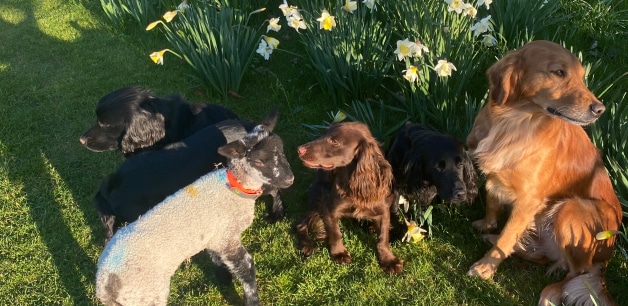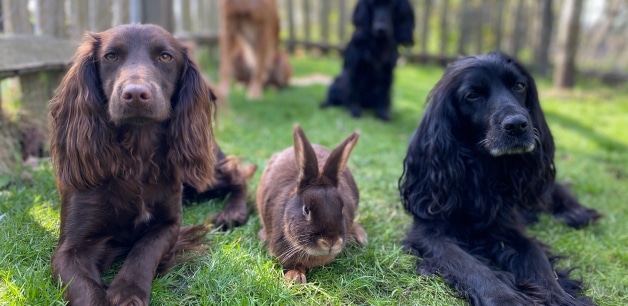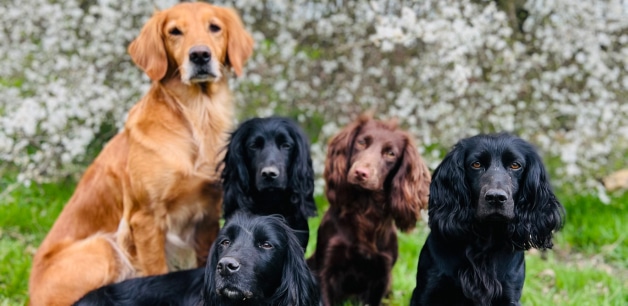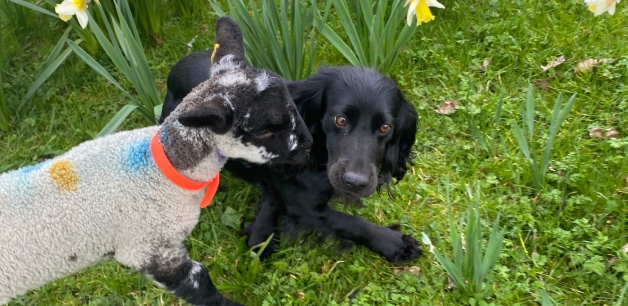Spring has finally sprung! What does that mean for my dog?
Spring is my favourite time of year. I always feel refreshed and energetic when the warmer weather hits and the days grow longer. However, it’s not just us humans who feel different this time of year. My pack of six certainly enjoy letting me know when spring is knocking on the door!
Have you ever wondered if spring can impact your dog’s health and behaviour? Dogs are known to experience several changes during spring. This blog will aim to provide some helpful information so that you can manage these seasonal changes and enjoy spring with your dog safely.

Why is my dog more excitable during spring?
I don’t know about you, but I tend to feel more excited and alert this time of year, especially when the clocks spring forward! This feeling is usually referred to as spring fever, and I often find myself noticing similar side effects and behaviours in my dogs too.
Springtime presents a whole host of new smells for our four-legged friends to sniff out, such as blooming flowers and trees releasing pollen into the environment. Small animals coming out of hibernation also leave lots of new scents for your dog to investigate. These seasonal changes can sometimes result in a sensory overload for our dogs.
With all of the exciting new scents, spring can also bring about changes in temperament and behaviour. This could include bolting, escaping from gardens in pursuit of a new smell, and ignoring commands – Inka’s favourite!
Not all dogs react this way during springtime, but it’s important to be aware of the possibility, just in case. Especially as it could put your dog at an increased risk of running into traffic, chasing livestock or an unexpected trip to the vet. Thankfully, there are lots of things you can do to help address these issues.

How to deal with spring fever in dogs
Spring fever can affect dogs in lots of different ways. Over the years I’ve learnt to recognise some of these changes in my dogs, and I thought it might be useful to list a few of them below. Especially as Easter is just around the corner!
Practise recall training
Heightened senses during spring can mean your dog is easily distracted. Dogs can exhibit selective hearing, which means they might not always come back on command. As the weather begins to warm up during spring, my dogs and I like to go out and spend time practising recall in a safe environment. This is a great spring strategy to adopt, because it will help to reinforce your bond and positive behaviour whilst out and about. If you need help teaching your dog recall, check out my recall training video.
Keep your dog under control near livestock
Springtime means an abundance of baby animals, especially in rural areas. Your dog might want to investigate new animal scents during walks. But it’s important to never let them chase any livestock. This is illegal, and also dangerous for both the animals and your dog. Always keep them under control by walking to heel, or on a lead, especially around spring lambs.
Similarly, urban areas can also present new animals such as squirrels and foxes, which most dogs find very tempting to chase! This could put them at an increased risk of running into a busy road. It’s therefore equally important to keep your dog under control in urban areas, to help keep you and your dog as safe as possible.
Don’t forget flea and worm prevention
Ticks, fleas and worms can be rife during spring. Ensure your dog is up to date with their flea and worming regime. It’s the best way to keep unwanted bugs and parasites away! If you’re unsure of how to manage your dog’s flea and worming programme, ask your vet for advice.
Rinse fur after walks
Many dogs suffer from skin irritation during spring – including mine! Washing down their legs with water after walks can be a good way to help relieve itchiness. This also helps to remove any pollen and dust stuck to the fur, which can cause discomfort.
Explore new locations
Your dog will be excited by all of the new smells in the air during spring. Mixing up their walks in new places is a great way to help them explore more sensory stimuli. This is not only great for mental enrichment, but it also allows them to safely investigate all of the new smells in the air.

Spring dangers to be aware of
It’s important to remember that seasonal changes also bring environmental risks. Below are some common spring dangers that I always look out for when I’m out with my dogs.
Seasonal allergies
I often find myself reaching for an antihistamine when spring hits. That dry, scratchy throat, runny nose and itchy skin feeling is one I know all too well! Hayfever can be a nightmare to manage for us humans, but have you ever wondered how seasonal allergies can affect our dogs?
You may notice your dog licking and chewing their paws often this time of year. Perhaps they also scratch their ears a lot, scoot their bottom across the floor, or have sore eyes and a runny nose? These are all signs of seasonal allergies, and they can be present in both adult dogs and puppies. They can be very common during spring, and are not always linked to diet alone.
Toxic plants your dog should avoid
Spring brings about lots of beautiful blooming plants! You will probably find that your dog will love to explore in the undergrowth, taking in all of the new sights and smells. However, remember to keep an eye on your dog during walks, as some spring plants can be toxic to dogs if ingested. Here are some common ones to avoid:
Tulips
Daffodils
Lilies
Rapeseed
Bluebells
If you suspect that your dog has snacked on a poisonous plant, keep a close eye on them. In most cases, a vet trip isn’t required. However, if you notice symptoms such as vomiting, diarrhoea, loss of appetite or seizures, then the poisoning could be severe. In these instances, get your dog to the vet as soon as possible.

Is your dog ready to spring into action?
No pun intended…
I hope this blog has been helpful to introduce you to some of the common seasonal changes our dogs can experience this time of year.
Knowing what signs to look out for will enable you to be prepared when the clock strikes spring! But remember, every dog is different, and only you know your dog best.
You might find it helpful to write down any changes that you notice in your dog during Spring, in a diary or journal. I like to use this method as sometimes I forget – six dogs is a lot! Re-visiting the diary the following year, before the season’s change will jog your memory and that way you can be better prepared!
As always, have fun – summer is just around the corner!
James & Ella x
